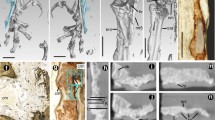Abstract
Tendons of the jaw adductor muscles of a hard prey crushing stingray exhibit similar adaptations to compressive and shear loads as those seen in mammalian tendons. Ventral intermandibular tendon from the cownose ray, Rhinoptera bonasus, has a prominent fibrocartilaginous pad that lies between a fibrous region of the tendon and the mineralized tissue of the jaw. Histologically the pad is similar to the fibrocartilaginous meniscus of mammals, and these tissues also share some biochemical traits. Proteoglycan (PG) content in the fibrocartilaginous pad is nearly four times higher than in the linearly arrayed tendinous tissue. The predominant PGs appear to be an aggrecan-like molecule and a decorin-like molecule. The decorin-like molecule is quite small when compared to mammalian decorin (20–80 kDa vs. 100–200 kDa). This study is the first to document adaptations to compressive/shear loading in tendon from a cartilaginous fish, and the similarities to the mammalian condition argue for the early evolution of this reactive ability of tendinous tissue.





Similar content being viewed by others
References
Al-Hakim A, Linhardt RJ (1990) Capillary electrophoresis for the analysis of chondroitin sulfate- and dermatan sulfate-derived disaccharides. Anal Biochem 95:68–73
Applegate SP (1967) A survey of shark hard parts. In: Gilbert PW, Mathewson RF, Rall DP (eds) Sharks, skates and rays. Johns Hopkins, Baltimore, pp 37–68
Bigelow HB, Schroeder WC (1948) Sharks. In: Tee-Van J (ed) Fishes of the western North Atlantic. Sears Foundation for Marine Research, New Haven, pp 59-576
Carvalho HF, Felisbino SL (1999) The development of the pressure-bearing tendon of the bullfrog, Rana catesbeiana. Anat Embryol 200:55–64
Coles RJ (1910) Observations on the habits and distribution of certain fishes taken on the coast of North Carolina. Bull Am Mus Nat Hist 28:338–341
Gillard GC, Merrilees MJ, Bell-Booth PG, Reilly GC, Flint MH (1977) The proteoglycan content and the axial periodicity of collagen in tendon. Biochemistry 163:145–151
Gudger EW (1914) History of the spotted eagle ray, Aëtobatus narinari, together with a study of its external structures. Carnegie Institution of Washington 183:241–323
Hall BK (1983) Cartilage. Academic, New York
Humason GL (1972) Animal tissue techniques, 3rd edn. WH Freeman, San Francisco
Koob TJ (1989) Effects of chondroitinase-ABC on proteoglycans and swelling properties of fibrocartilage in bovine flexor tendon. J Orthopaed Res 7:219–227
Koob TJ, Vogel KG (1987) Proteoglycan synthesis in organ cultures from regions of bovine tendon subjected to different mechanical forces. Biochem J 246:589–598
Krusius T, Ruoslahti E (1986) Primary structure of an extracellular matrix proteoglycan core protein deduced from cloned cDNA. Proc Natl Acad Sci U S A 83:7683–7687
Liem KF, Summers AP (1999) Gross anatomy and functional morphology of the muscles. In: Hamlett W (ed) Biology of elasmobranchs. Johns Hopkins University Press, Baltimore
Okuda Y, Gorski JP, An K-N, Amadio PC (1987) Biochemical, histological, and biomechanical analyses of canine tendon. J Orthoped Res 5:60–68
Ørvig T (1951) Histologic studies of placoderm and fossil elasmobranchs. I. The endoskeleton, with remarks on the hard tissues of lower vertebrates in general. Arkiv Zool 2:321–454
Sakaguchi H et al. (2001) Isolation of reducing oligosaccharide chains from the chondroitin/dermatan sulfate-protein linkage region and preparation of analytical probes by fluorescent labeling with 2-aminobenzamide. J Biochem 129:107–118
Smith MM, Hall BK (1990) Development and evolutionary origins of vertebrate skeletogenic and odontogenic tissues. Biol Rev 65:277–373
Summers AP (2000) Stiffening the stingray skeleton—an investigation of durophagy in myliobatid stingrays (Chondrichthyes, Batoidea, Myliobatoidea). J Morphol 243:113—126
Summers AP, Koob TJ (2002) The evolution of tendon. Comp Biochem Physiol 133:1159—1170
Summers AP, Koob TJ, Brainerd EL (1998) Stingray jaws strut their stuff. Nature 395:450—451
Templeton DM (1988) The basis and applicability of the dimethylmethylene blue binding assay for sulfated glycosaminoglycans. Conn Tissue Res 17:23—32
Vogel KG, Koob TJ (1989) Structural specializations in tendons under compression. Int Rev Cytol 115
Vogel KG, Sandy JD, Pogany G, Robbins JR (1994) Aggrecan in bovine tendon. Matrix Biol 14:171–179
Acknowledgements
John Tyminski, Mason Dean, Jose Castro and Bob Hueter were very helpful in obtaining fresh specimens of the cownose ray as well as comparative material from other species.
Author information
Authors and Affiliations
Corresponding author
Additional information
This research was supported by grants from the McDowell Foundation to A.P.S.
Rights and permissions
About this article
Cite this article
Summers, A.P., Koob-Emunds, M.M., Kajiura, S.M. et al. A novel fibrocartilaginous tendon from an elasmobranch fish (Rhinoptera bonasus). Cell Tissue Res 312, 221–227 (2003). https://doi.org/10.1007/s00441-003-0714-4
Received:
Accepted:
Published:
Issue Date:
DOI: https://doi.org/10.1007/s00441-003-0714-4




